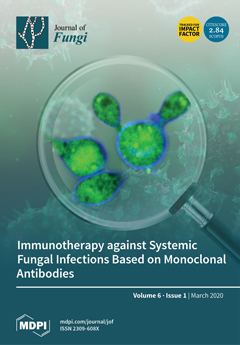Biofilms, structured and densely packed communities of microbial cells attached to surfaces, are considered to be the natural growth state for a vast majority of microorganisms. The ability to form biofilms is an important virulence factor for most pathogens, including the opportunistic human fungal pathogen
Candida albicans.
C. albicans is one of the most prevalent fungal species of the human microbiota that asymptomatically colonizes healthy individuals. However,
C. albicans can also cause severe and life-threatening infections when host conditions permit (e.g., through alterations in the host immune system, pH, and resident microbiota). Like many other pathogens, this ability to cause infections depends, in part, on the ability to form biofilms. Once formed,
C. albicans biofilms are often resistant to antifungal agents and the host immune response, and can act as reservoirs to maintain persistent infections as well as to seed new infections in a host. The majority of
C. albicans clinical isolates are heterozygous (
a/α) at the mating type-like (
MTL) locus, which defines
Candida mating types, and are capable of forming robust biofilms when cultured in vitro. These “conventional” biofilms, formed by
MTL-heterozygous (
a/α) cells, have been the primary focus of
C. albicans biofilm research to date. Recent work in the field, however, has uncovered novel mechanisms through which biofilms are generated by
C. albicans cells that are homozygous or hemizygous (
a/
a,
a/Δ, α/α, or α/Δ) at the
MTL locus. In these studies, the addition of pheromones of the opposite mating type can induce the formation of specialized “sexual” biofilms, either through the addition of synthetic peptide pheromones to the culture, or in response to co-culturing of cells of the opposite mating types. Although sexual biofilms are generally less robust than conventional biofilms, they could serve as a protective niche to support genetic exchange between mating-competent cells, and thus may represent an adaptive mechanism to increase population diversity in dynamic environments. Although conventional and sexual biofilms appear functionally distinct, both types of biofilms are structurally similar, containing yeast, pseudohyphal, and hyphal cells surrounded by an extracellular matrix. Despite their structural similarities, conventional and sexual biofilms appear to be governed by distinct transcriptional networks and signaling pathways, suggesting that they may be adapted for, and responsive to, distinct environmental conditions. Here we review sexual biofilms and compare and contrast them to conventional biofilms of
C. albicans.
Full article






